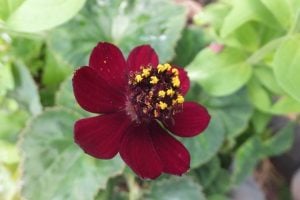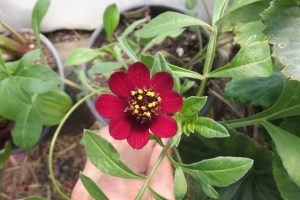I doubt anyone entering your glasshouse will gasp “What a gorgeous specimen” when their eyes glance upon Cosmos atrosanguineus Chocamocha. Admittedly this is an undistinguished leaved scantily flowering almost scruffy looking plant you’d not look twice at. However once their noses catch the delicious vanilla and hot chocolate scent they will be entranced. Then as their eyes adjust they may also be captivated by those dark crimson flowers which are so intricate, so richly coloured encrusted with golden pollen and perfume.

Now Chocolate Cosmos is closely related to but not one of the many annual Cosmos that give so much value to our summer and autumn displays in the open garden. No, this Cosmos is perennial, and comes from tubers (though it could be started from seed). Introduced from Mexico in 1860 it has been grown ever since just for that lovely scent though not very widely, then in recent years it has been rediscovered and is popular again.

This is hardy, but only barely so’s seldom grown outside. Anyway out there that scent would be lost on the wind whereas under cover it’s so appealing. Thus as the plants are not visually important they can be relegated to the back of a sunny bench – but not so far back those flowers are beyond the reach of your nose.
Really remarkably easy to grow, you plant tubers in spring in any good free draining compost. A frost free greenhouse is sufficient but giving bottom heat will help accelerate their early growth and produce much bigger specimens. A Chocolate Cosmos can make over a metre tall and across, and though usually less still needs a large pot or small tub to flower well.

Feed and water regularly though this is not especially thirsty nor hungry, nor prone to pests other than the usual culprits (snails may damage the leaves). Indeed this only needs extra attention as the foliage withers back in autumn. Then trim the haulm back to a few inches and keep the tubers in their pots in their dry compost till they recommence growth in spring when you can start watering and feeding again.
Oddly there are no varieties on offer, very experimental gardeners might try making hybrids with the annual species as success could be well worth having.










